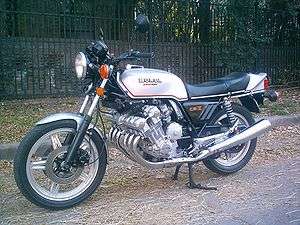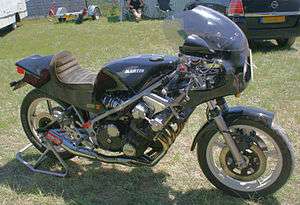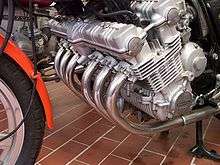Honda CBX
The Honda CBX was a sports motorcycle manufactured by Honda from 1978 to 1982. With a 1047cc inline six-cylinder engine producing 105 bhp (78 kW), it was the flagship of the Honda range. The CBX was well-received by the press, but was outsold by its sibling, the Honda CB900F.[10]
 | |
| Manufacturer | Honda |
|---|---|
| Production | 1978–1982 |
| Class | Superbike |
| Engine | 1,047 cc (63.9 cu in), 24-valve, twin-cam, air-cooled, inline-6 6 carburetors |
| Bore / stroke | 64.5 mm × 53.4 mm (2.54 in × 2.10 in) |
| Compression ratio | 9.3:1 |
| Top speed | 134–140 mph (216–225 km/h)[1][2][3] |
| Power | 105 hp (78 kW)@ 9,000 rpm (claimed) 1978-1980[4][5] 100–103 hp (75–77 kW) (claimed) 1981-1982[6][7] 98 hp (73 kW) (rear wheel)[8] |
| Torque | 63 lb⋅ft (85 N⋅m)@ 8,000 rpm(claimed)[9] |
| Transmission | 5-speed |
| Suspension | Front: 35 mm Telescopic fork Rear: Twin shock |
| Brakes | Front: Twin disc brakes 280 mm (11 in) Rear: Disc 305 mm (12.0 in) |
| Tires | Front 3.5 x 18" Rear 4.25 x 18" |
| Rake, trail | 27.5°, 4.7 in (120 mm) |
| Wheelbase | 1,495 mm (58.9 in) |
| Dimensions | L: 2,220 mm (87 in) W: 780 mm (31 in) H: 1,145 mm (45.1 in) |
| Seat height | 810 mm (32 in) |
| Weight | 246.7 kg (544 lb)[5] (dry) 272 kg (600 lb)[5] (wet) |
| Fuel capacity | 20 l (4.4 imp gal; 5.3 US gal) |
| Fuel consumption | 6.00 L/100 km; 47.1 mpg‑imp (39.2 mpg‑US)[5] |
As a promotional exercise, CBX bikes were ridden by travelling marshals at the 1979 & 1980 Isle of Man TT.[4]
Engine characteristics
Honda had produced a Honda RC series six-cylinder race bike in the mid-1960s, but the CBX was Honda's first production 6 cylinder road bike with this GP racing engine technology.[9] The CBX's advanced DOHC 24-valve inline six-cylinder engine was its outstanding feature; but in other respects the bike was conventional, having telescopic forks, a tubular frame, twin rear shocks and straight handlebars.[6][8]
Although bulky, it was only two inches wider than a CB750,[9] the engine was wide only at the top. The width across the crankshaft was relatively narrow as the CBX had a stacked engine accessory arrangement, whereby the alternator and ignition items were positioned behind the cylinder block. This arrangement produced an acceptable engine width low down and moved critical items out of harm's way in the event of grounding.[8]
Journalist L. J. K. Setright wrote of the CBX's width: "Don't tell me that its engine is too wide: It is no wider than the legs of a rider, so it adds nothing to the frontal area, and personally I would rather have my legs shielded by a cylinder apiece than exposed to every blow ..."[10]
Sport touring model
In 1981, Honda repositioned the CBX into the sport touring category with the CBX-B, detuning the engine to 100–103 hp (75–77 kW) and adding Pro-Link monoshock rear suspension, air-adjustable 39 mm front forks, a fairing and panniers with a stronger frame to support these additions.[6] The CBX was given beefier dual ventilated front brake discs to help bring to a stop the bike's increased weight. The 1982 model CBX-C model differed little from the 1981 model, having only some changes to paint and trim.
Reception
In the February 1978 issue of Cycle (magazine) editor Cook Neilson wrote this of a review of a pre-production bike, after a four-day review at Orange County Raceway, Willow Springs Raceway, and the Webco dynamometer: "The objective - to build the fastest production motorcycle for sale anywhere in the world - has been met." [11] Comparing the CBX to the CB900F, Setright added,"The CBX feels better and goes better, and the difference is greater than the difference in price, so the costlier bike is actually the better bargain. ... The CBX engine is as responsive as a racer, the nicest cycle motor to ever reach the street.".[10]
The CBX was not the first production motorcycle to be powered by a six-cylinder engine (the first was the 1972–1978 Benelli 750 Sei, based on the Honda CB500 Four) but it was the latest and most advanced entry into the competitive superbike market. A review in Cycle magazine called the CBX a "breakthrough for the Japanese motorcycle industry" and praised its design, concept, and performance.[12] The CBX was available on the market in late 1978, and the production model was even faster than the prototype.[8] Cycle World got a tested 1/4 mile time of 11.64 seconds at 117.95 mph (189.82 km/h), the 1978 bike was also the first bike they tested to go over 130 mph (210 km/h).[1] The 1979 CBX could cover a quarter mile in 11.36 seconds with a terminal speed of 189.82 km/h (117.95 mph).[13] But later CBXs with the addition of saddlebags and a fairing were detuned, and showed the 1981 CBX had lost five hp compared to the 1978 model, from 105 hp down to 100 hp.[7][6]
Cycle Guide praised the bike as "the Vincent Black Shadow of 1979" upon its introduction.[14] In 2011, Australian publication 2 Wheels Magazine named the CBX as one of their favourite 12 superbikes ever.
To avoid confusion with Honda CBX series bikes, the CBX is sometimes referred to as the CBX1000.
Moto Martin CBX
In 1984, the Frenchman Georges Martin of the French firm Moto Martin, designed and built a lighter and stiffer nickel tube frame capable of controlling the CBX motor, and supplied this chassis in kit form.
The original bike had handling issues if ridden hard and was heavy at 260 kg (580 lb). Moto Martin isolated the handling problems and eliminated them by unbolting the engine and throwing everything else away. The new frame was both stiffer and lighter than the original and tied the front and back of the bike together. The stock 37mm tubes were replaced for 42mm Moto Martin forks and mounted the single, rear shock horizontally under the seat. They used Brembo brakes and a one piece fiberglass seat/tank/tail section café racer style and managed to lose nearly 36 kg (80 lb).
A 1984 issue of Cycle News praise the Moto Martin’s road manners. Smith says his bike is “always stable.” Cycle News shaved four seconds off the previous best CBX lap time at Willow Springs.[15][16][17]
- Honda CBX
 Sport touring model
Sport touring model
 custom
custom.jpg)
 Moto Martin-framed CBX
Moto Martin-framed CBX Honda CBX Engine Detail
Honda CBX Engine Detail
Bibliography
- Kuch, Joachim: Honda. Motorräder seit 1970. (in German) Stuttgart: Motorbuch-Verlag, 2000, ISBN 3-613-02061-0, p.50-51
- Limpf, Martin: Das Motorrad. Seine technische und geschichtliche Entwicklung dargestellt anhand der einschlägigen Fachliteratur. (in German) München: R. Oldenbourg Verlag, 1983, ISBN 3-486-27571-2, p. 59-63
- Foster, Ian: The CBX Book, part 1 and 2
See also
Notes
- Burns, John (April 2, 2012), "Fifty Years of "Do You Have Any Idea How Fast You Were Going?" A brief history of Ludicrous Speed", Cycle World, archived from the original on April 7, 2012, retrieved March 7, 2017CS1 maint: unfit url (link)
- "1981 Honda CBX". American Motorcyclist Association. Retrieved January 16, 2018.
- Anderson, Ric (January–February 2006). "Honda CBX". Motorcycle Classics. Retrieved January 16, 2018.CS1 maint: date format (link)
- "Honda CBX1000". Carole Nash. June 20, 2008. Retrieved March 10, 2016.
- Cameron, Kevin (September 22, 2016). "Honda CBX1000 - CLASSICS REMEMBERED". Cycle World. Retrieved September 30, 2016.
- Greg Williams (November–December 2009). "1981 Honda CBX". Motorcycle Classics. Retrieved 11 November 2009.
- Bowen, Simon (January 11, 2011). "Classic Scrap: Honda CBX1000 vs. Kawasaki Z1300". Visordown. Archived from the original on March 11, 2011. Retrieved 10 March 2016.CS1 maint: unfit url (link)
- "Suzuki GS 1100 vs. Honda CBX: Is There a New Superbike King?". Motorcyclist. March 1980.
- Frank, Melling (November 13, 2015). "Classic bikes: Honda CBX". The Telegraph. Retrieved January 16, 2018.
- Setright, L. J. K. (February 1980), CB900F vs CBX: the 995 percent solution, 14, Cycle Guide Publications – via General OneFile (subscription required) , p. 86
- Boehm, Mitch (April 2016), "THE STATEMENT", Motorcyclist, pp. 48–52
- Frank, Aaron (2003). Honda Motorcycles. Motorbooks International. pp. 112–115. ISBN 978-0-7603-1077-9.
- "HONDA CBX Grand Prix Glamour and Touring Chic". Cycle World. July 1981.
- Ric Anderson (January–February 2006). "Honda CBX: The Power of Six Cylinders". Motorcycle Classics. Retrieved 19 August 2009.
- Johnson, Troy (September 23, 1996). "September 1996 – Bike Builders: Moto Martin CBX". Minnesota Motorcycle Monthly. Retrieved August 12, 2018.
- "Is this the ultimate Honda CBX1000?". MCN. March 16, 2012. Retrieved August 12, 2018.
- "European finesse for Honda's mighty CBX". Bonhams. January 7, 2016. Retrieved August 12, 2018.